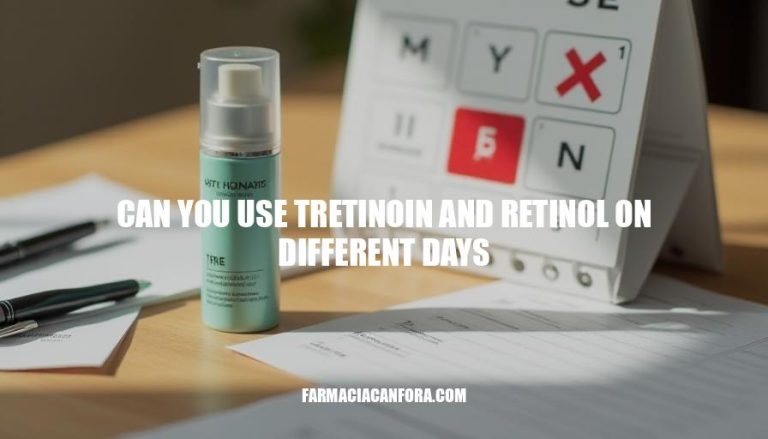


Tretinoin and retinol are two powerful skincare ingredients. Tretinoin is a strong version of vitamin A that helps with acne, aging, and skin cell turnover. Retinol is a gentler version that offers similar benefits but with less risk of irritation.
Alternating between these products can help you get the best of both worlds without overwhelming your skin.
This way, you can use tretinoin for its strong benefits while giving your skin a break with retinol’s milder touch. By using both in moderation, you can keep your skin healthy and resilient.
Using tretinoin and retinol on alternating days offers a strategic approach to skincare, maximizing their benefits while minimizing potential irritation. Both are retinoids derived from Vitamin A, but tretinoin is a prescription-strength compound, while retinol is milder and available over the counter. Their interaction with the skin involves accelerating cell turnover, reducing fine lines, improving texture, and addressing acne.
However, their potency and similar mechanisms can lead to over-exfoliation and irritation if used simultaneously.
By alternating their application, the skin is given time to adjust and recover, reducing the risk of redness, peeling, and sensitivity. This method ensures that the skin reaps the benefits of both ingredients without overwhelming its barrier. Tretinoin’s strength targets deeper skin concerns like severe acne or pronounced wrinkles, while retinol provides a gentler exfoliation and collagen boost, complementing tretinoin’s effects.
Understanding how these active ingredients interact with the skin is crucial for achieving optimal results.
This approach not only prevents irritation but also enhances the overall efficacy of the skincare routine, promoting a balanced and radiant complexion.
Alternating between tretinoin and retinol on different days can be a practical approach to skincare, allowing you to harness the benefits of both ingredients while minimizing potential irritation. By using tretinoin for its strong benefits and retinol’s milder touch in moderation, you can keep your skin healthy and resilient.
This alternating method ensures that your skin has time to adjust and recover from the stronger effects of tretinoin, reducing the risk of redness, peeling, and sensitivity. Tretinoin targets deeper skin concerns like severe acne or pronounced wrinkles, while retinol provides a gentler exfoliation and collagen boost, complementing tretinoin’s effects.
To get the most out of this approach, it’s essential to understand how these active ingredients interact with your skin. Consulting a dermatologist can help you personalize your skincare regimen and determine the best way to incorporate tretinoin and retinol into your routine.
Consistency and patience are key when using tretinoin and retinol. It may take some time for your skin to adjust, but with regular use and alternating application, you can achieve a balanced and radiant complexion. Remember to consult a dermatologist before starting any new skincare products, especially if you’re considering prescription-strength ingredients like tretinoin.